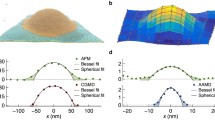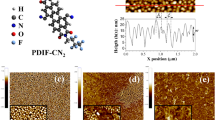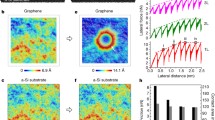Abstract
Molecular dynamics simulations were used to study pressure-controlled wetting behavior of a nanostructured surface. Model graphene-like material functionalized by nanosized asperities was shown to support reversible dynamic transitions between superhydrophobic Cassie states that minimize contact with water and completely wetted Wenzel states. In practical applications, similar reversibility has been achieved by hierarchical corrugations, air trapping, or tailored geometry of surface posts. Nano corrugations alone are shown to secure a robust Cassie state at low pressures, support transition to Wenzel state at pressure of O(102) atm and can recover the Cassie regime without prohibitive hysteresis upon decompression. For O(10) nm surface fragments, timescales of dynamic response to compression deduced from the relaxation rates of water uptake fluctuations were estimated in the range of 0.1–1 ns. On small surfaces, an essentially barrier-free transition to Wenzel state is typically initiated at surface edges, followed by cooperative spreading across the entire surface. Conversely, the recovery of the Cassie state, which involves mild hysteresis, relies on nucleation away from the edges and should therefore be essentially independent of surface size. In conventional picture, cycling rate is determined by the latter process. This suggests subnanosecond responses of surface wettability could also be realized on macroscopic samples, leaving pressure control as the practical rate determinant in eventual application.









Similar content being viewed by others
References
C.G. Jothi Prakash, R. Prasanth, Approaches to design a surface with tunable wettability: a review on surface properties. J. Mater. Sci. 56, 108–135 (2021)
Q.H. Zeng, H. Zhou, J.X. Huang, Z.G. Guo, Review on the recent development of durable superhydrophobic materials for practical applications. Nanoscale 13, 11734–11764 (2021)
S.N. Smirnov, I.V. Vlassiouk, N.V. Lavrik, Voltage-gated hydrophobic nanopores. ACS Nano 5, 7453–7461 (2011)
M.R. Powell, L. Cleary, M. Davenport, K.J. Shea, Z.S. Siwy, Electric-field-induced wetting and dewetting in single hydrophobic nanopores. Nat. Nanotechnol. 6, 798–802 (2011)
Y. Grosu, M. Mierzwa, V.A. Eroshenko, S. Pawlus, M. Chorazewski, J.M. Nedelec, J.P.E. Grolier, Mechanical, thermal, and electrical energy storage in a single working body: electrification and thermal effects upon pressure-induced water intrusion extrusion in nanoporous solids. ACS Appl. Mater. Interfaces 9, 7044–7049 (2017)
A. Tinti, A. Giacomello, Y. Grosu, C.M. Casciola, Intrusion and extrusion of water in hydrophobic nanopores. Proc. Natl. Acad. Sci. USA 114, E10266–E10273 (2017)
E. Bormashenko, Progress in understanding wetting transitions on rough surfaces. Adv. Coll. Interface Sci. 222, 92–103 (2015)
B. Liu, F.F. Lange, Pressure induced transition between superhydrophobic states: Configuration diagrams and effect of surface feature size. J. Coll. Interface Sci. 298, 899–909 (2006)
W.Q. Ren, Wetting transition on patterned surfaces: transition states and energy barriers. Langmuir 30, 2879–2885 (2014)
A. Checco, B.M. Ocko, A. Rahman, C.T. Black, M. Tasinkevych, A. Giacomello, S. Dietrich, Collapse and reversibility of the superhydrophobic state on nanotextured surfaces. Phys. Rev. Lett. 112, 216101 (2014)
A. Lafuma, D. Quere, Superhydrophobic states. Nat. Mater. 2, 457–460 (2003)
D. Quere, Wetting and roughness. Ann. Rev. Mater. Res. 38, 71–99 (2008)
F. Leroy, F. Muller-Plathe, Rationalization of the behavior of solid-liquid surface free energy of water in Cassie and Wenzel wetting states on rugged solid surfaces at the nanometer scale. Langmuir 27, 637–645 (2011)
P. Forsberg, F. Nikolajeff, M. Karlsson, Cassie-Wenzel and Wenzel-Cassie transitions on immersed superhydrophobic surfaces under hydrostatic pressure. Soft Matter 7, 104–109 (2011)
G. Whyman, E. Bormashenko, How to make the Cassie wetting state stable? Langmuir 27, 8171–8176 (2011)
M.S. Dhindsa, N.R. Smith, J. Heikenfeld, P.D. Rack, J.D. Fowlkes, M.J. Doktycz, A.V. Melechko, M.L. Simpson, Reversible electrowetting of vertically aligned superhydrophobic carbon nanofibers. Langmuir 22, 9030–9034 (2006)
J. Heikenfeld, M. Dhindsa, Electrowetting on superhydrophobic surfaces: present status and prospects. J. Adhes. Sci. Technol. 22, 319–334 (2008)
F. Mugele, Electrical switching of wetting states on superhydrophobic surfaces: a route towards reversible Cassie-to-Wenzel transitions. Phys. Rev. Lett. 106, 014501 (2011)
D. Vanzo, A. Luzar, D. Bratko, Reversible electrowetting transitions on superhydrophobic surfaces. Phys. Chem. Chem. Phys. 23, 27005–27013 (2021)
G. Whyman, E. Bormashenko, Wetting transitions on rough substrates: general considerations. J. Adhes. Sci. Technol. 26, 207–220 (2012)
C.D. Daub, J. Wang, S. Kudesia, D. Bratko, A. Luzar, The influence of molecular-scale roughness on the surface spreading of an aqueous nanodrop. Faraday Discuss. 146, 67–77 (2010)
T. Verho, J.T. Korhonen, L. Sainiemi, V. Jokinen, C. Bower, K. Franze, S. Franssila, P. Andrew, O. Ikkala, R.H.A. Ras, Reversible switching between superhydrophobic states on a hierarchically structured surface. Proc. Natl. Acad. Sci. USA 109, 10210–10213 (2012)
K. Leung, A. Luzar, Dynamics of capillary evaporation. II. Free energy barriers. J. Chem. Phys. 113, 5845–5852 (2000)
S. Sharma, P.G. Debenedetti, Free energy barriers to evaporation of water in hydrophobic confinement. J. Phys. Chem. B 116, 13282–13289 (2012)
T. Werder, J.H. Walther, R.L. Jaffe, T. Halicioglu, P. Koumoutsakos, On the water-carbon interaction for use in molecular dynamics simulations of graphite and carbon nanotubes. J. Phys. Chem. B 107, 1345–1352 (2003)
V.B. Mbayachi, E. Ndayiragije, T. Sammani, S. Taj, E.R. Mbuta, A. Khan, Graphene synthesis, characterization and its applications: a review. Results Chem. 3, 100163 (2021)
A.R. Leach, Molecular Modelling: Principles and Applications (Prentice Hall, London, 2001)
B. Lee, F.M. Richards, Interpretation of protein structures-estimation of static accessibility. J. Mol. Biol. 55, 379–380 (1971)
M.L. Connolly, Solvent-accessible surfaces of protein and nucleic-acids. Science 221, 709–713 (1983)
J.H. Wang, D. Bratko, A. Luzar, Probing surface tension additivity on chemically heterogeneous surfaces by a molecular approach. Proc. Natl. Acad. Sci. USA 108, 6374–6379 (2011)
Y.S. Li, D. Quere, C.J. Lv, Q.S. Zheng, Monostable superrepellent materials. Proc. Natl. Acad. Sci. USA 114, 3387–3392 (2017)
S. Plimpton, Fast parallel algorithms for short-range molecular-dynamics. J. Comput. Phys. 117, 1–19 (1995)
I.C. Yeh, M.L. Berkowitz, Ewald summation for systems with slab geometry. J. Chem. Phys. 111, 3155–3162 (1999)
M.P. Allen, D.J. Tildesley, Computer simulation of liquids (Oxford University Press, New York, 2017)
K. Lum, D. Chandler, Phase diagram and free energies of vapor films and tubes for a confined fluid. Int. J. Thermophys. 19, 845–855 (1998)
D. Bratko, R.A. Curtis, H.W. Blanch, J.M. Prausnitz, Interaction between hydrophobic surfaces with metastable intervening liquid. J. Chem. Phys. 115, 3873–3877 (2001)
H. Acharya, S. Ranganathan, S.N. Jamadagni, S. Garde, Mapping hydrophobicity at the nanoscale: applications to heterogeneous surfaces and proteins. Faraday Discuss. 146, 353 (2010)
N. Giovambattista, P.J. Rossky, P.G. Debenedetti, Effect of pressure on the phase behavior and structure of water confined between nanoscale hydrophobic and hydrophilic plates. Phys. Rev. E 73, 041604 (2006)
R. Evans, M.C. Stewart, The local compressibility of liquids near non-adsorbing substrates: a useful measure of solvophobicity and hydrophobicity? J. Phys. Cond. Matter 27, 194111 (2015)
D. Vanzo, D. Bratko, A. Luzar, Wettability of pristine and alkyl-functionalized graphane. J. Chem. Phys. 137, 034707 (2012)
D. Vanzo, D. Bratko, A. Luzar, Nanoconfined water under electric field at constant chemical potential undergoes electrostriction. J. Chem. Phys. 140, 074710 (2014)
D. Vanzo, D. Bratko, A. Luzar, Dynamic control of nanopore wetting in water and saline solutions under an electric field. J. Phys. Chem. B 119, 8890–8899 (2015)
N. Ojaghlou, D. Bratko, M. Salanne, M. Shafiei, A. Luzar, Solvent-solvent correlations across graphene: the effect of image charges. ACS Nano 14, 7987–7998 (2020)
S. Zamfir, F. Moucka, D. Bratko, High-pressure infiltration-expulsion of aqueous NaCl in planar hydrophobic nanopores. J. Phys. Chem. C 124, 23433–23445 (2020)
H.J.C. Berendsen, J.R. Grigera, T.P. Straatsma, The missing term in effective pair potentials. J. Phys. Chem. 91, 6269–6271 (1987)
C.D. Daub, D. Bratko, K. Leung, A. Luzar, Electrowetting at the nanoscale. J. Phys. Chem. C 111, 505–509 (2007)
J.A. Ritchie, J.S. Yazdi, D. Bratko, A. Luzar, Metastable sessile nanodroplets on nanopatterned surfaces. J. Phys. Chem. C 116, 8634–8641 (2012)
J. Driskill, D. Vanzo, D. Bratko, A. Luzar, Wetting transparency of graphene in water. J. Chem. Phys. 141, 18C517 (2014)
B.S. Jabes, J. Driskill, D. Vanzo, D. Bratko, A. Luzar, Metastable vapor in a janus nanoconfinement. J. Phys. Chem. C 121, 13144–13150 (2017)
Y. Kopel, N. Giovambattista, Comparative study of water-mediated interactions between hydrophilic and hydrophobic nanoscale surfaces. J. Phys. Chem. B 123, 10814–10824 (2019)
D. Bratko, C.D. Daub, K. Leung, A. Luzar, Effect of field direction on electrowetting in a nanopore. J. Am. Chem. Soc. 129, 2504–2510 (2007)
R. Evans, Fluids adsorbed in narrow pores - phase-equilibria and structure. J. Phys. Cond. Matt. 2, 8989–9007 (1990)
K. Lum, A. Luzar, Pathway to surface-induced phase transition of a confined fluid. Phys. Rev. E 56, R6283–R6286 (1997)
K. Leung, A. Luzar, D. Bratko, Dynamics of capillary drying in water. Phys. Rev. Lett. 90, 065502 (2003)
E. Bormashenko, R. Pogreb, G. Whyman, M. Erlich, Resonance Cassie-Wenzel wetting transition for horizontally vibrated drops deposited on a rough surface. Langmuir 23, 12217–12221 (2007)
C. Ishino, K. Okumura, Nucleation scenarios for wetting transition on textured surfaces: the effect of contact angle hysteresis. Europhys. Lett. 76, 464–470 (2006)
S. Gupta, A. Irback, B. Petersson, R.V. Gavai, F. Karsch, The correlation lengths and the order of the phase transition in 3-dimensional z-3 symmetric models. Nuclear Phys. B 329, 263–284 (1990)
R.G. Cox, The dynamics of the spreading of liquids on a solid surface. Part 2. Surfactants. J. Fluid Mech. 168, 192–220 (1986)
P.G. de Gennes, F. Brochard-Wyart, Dynamics of partial wetting. Adv. Colloid Interface Sci. 39, 1–11 (1992)
M. Ramiasa, J. Ralston, R. Fetzer, R. Sedev, The influence of topography on dynamic wetting. Adv. Coll. Interface Sci. 206, 275–293 (2014)
Acknowledgements
We acknowledge National Science Foundation for support (award CHE-1800120) and Extreme Science and Engineering Discovery Environment (XSEDE), funded by NSF Grant No. OCI-1053575, and the National Energy Research Scientific Computing Center (NERSC), funded by the Office of Science of the U.S. Department of Energy (No. DEAC02-05CH11231) for supercomputing time allocations.
Author information
Authors and Affiliations
Corresponding author
Ethics declarations
Conflict of interest
There are no conflicts to declare.
Additional information
Publisher's Note
Springer Nature remains neutral with regard to jurisdictional claims in published maps and institutional affiliations.
A. Luzar: Deceased on March 5, 2019.
Supplementary Information
Below is the link to the electronic supplementary material.
Supplementary file2 (MP4 55291 kb)
Supplementary file3 (MPG 44451 kb)
Rights and permissions
About this article
Cite this article
Vanzo, D., Luzar, A. & Bratko, D. Pressure-sensitive conversions between Cassie and Wenzel wetting states on a nanocorrugated surface. Appl. Phys. A 128, 323 (2022). https://doi.org/10.1007/s00339-022-05458-4
Received:
Accepted:
Published:
DOI: https://doi.org/10.1007/s00339-022-05458-4




